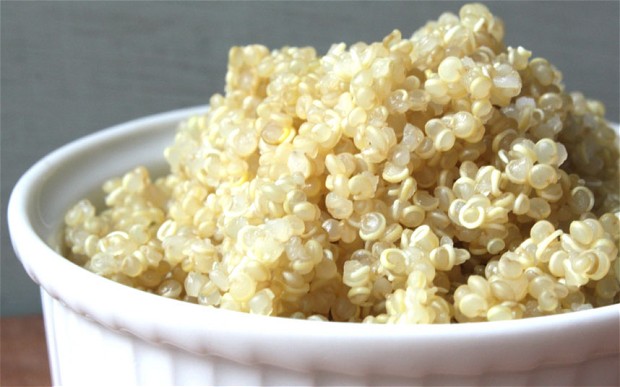Pronounced keen-wa (or kwin-noa), sales of this super-grain have shot up in the last decade. Praised for its high nutrient content it is now very popular as an alternative to rice and couscous.So where has it come from? Quinoa(Chenopodium quinoa,Willd) has been a staple food for the South American populations for thousands of years. Classed as a pseudocereal quinoa is not a grass and therefore not actually a grain like wheat, rice, oats and barley, but actually a seed. The seeds look like small lentils and have a characteristic outer ring when cooked.

Available in red, white, yellow and black colours, the red and white ones are sold in the UK, in dry packs and pre-cooked packs. Quinoa can also now found in ready to heat microwave packets mixed with other cereals such as wholegrain rice and bulgar wheat.
“not actually
a grain”
The UK imported 3,000 tonnes of quinoa in 2015 mostly from Peru. What was seen only in specialist health food shops is now found in supermarkets countrywide. Waitrose has seen sales of their fresh quinoa salads rise “23% higher year-on-year” [1]. The UK is now growing its own quinoa and supplies Waitrose and Pret-a-Manger, among the growers is the British Quinoa Co. successfully farming quinoa in Shropshire.
“high in protein,
vitamins and
minerals”
You can find lots of nutritional information of quinoa quoting its high protein content : 14% but this is somewhat misleading as the quote is based on dry uncooked weight and rather than cooked. Nevertheless, even after cooking quinoa’s protein value is higher than brown rice and couscous 4.4% compared with 2.8% brown rice, and 3.8% couscous [2].
What gives the quinoa the edge is that it contains a full set of the nine essential amino acids we need from our diet and is therefore classed as a complete protein [3]
“ A COMPLETE
protein – contains
all essential amino
acids needed
in our diet”
Grains lack one or two of these essential amino acids, as do legumes (lentils and beans). Nutritionally speaking grains and legumes need to be complemented with each other in order to provide the full set of amino acids. A source of complete protein is beneficial to vegans and vegetarians who may struggle with adequate protein intake.
Quinoa is also higher in B1, B2 and B6 vitamins as well as containing more magnesium, zinc and iron minerals when compared to brown rice and couscous – so overall a better alternative. It also has small amounts of omega 3 fatty acids which are anti-inflammatory, and contains some powerful antioxidants too [4].
“The UN declared
2013 International
Year of Quinoa”
Quinoa is called a “functional food” by many for its benefits to human health [5]
The United Nations declared 2013 as “International year of quinoa” promoting its importance for food security for the future of the world’s population.
Other health benefits include that it contains no gluten, it is used in its flour form in many gluten-free breads, biscuits and cakes. There have been some reports that certain varieties of quinoa can cause a reaction in some people who are coeliac, but this is only if these varieties are consumed to excess. Research has shown that 50g daily portions for a period of 6 weeks had no adverse effects on coeliacs [6]
Quinoa is also high in fibre which increases gut health and can promote weight loss [7,8].
So yes, it is a super-grain (seed), high in nutrients, a complete protein, gluten-free, high fibre, and grown in the UK. Why not try out the following recipe? You can easily adapt it to whatever vegetables you have , or use plain quinoa instead of rice or pasta.

Recipe: Quinoa salad with
apricots and chickpeas (serves 2)
Ingredients: 1 cup of quinoa, 1 chopped red
pepper, ½ red onion, handful baby spinach
leaves, 4 dried apricots chopped, ½ can
chickpeas, dressing: made up with 1tsp honey,
juice ½ lime, 100ml olive oil, salt and pepper.
Method: Rinse the quinoa under running water
before bringing to the boil in a pan with plenty of
water. Simmer over low heat until the grains
appear to lose their white outer ring (about
15mins). Drain and rinse under cold water and
allow to cool. Add the rest of the ingredients to
the quinoa and dressing to taste.
(One serving provides: 379kcal, 22% protein, 43%
fibre, 24% fat, and 15% carbohydrate – daily
reference intake of an average person)
References: [1] http://www.cityam.com/234187/uk-quinoa-imports-surge-in-2015-as-waitrose-reports-sales-jump-
[2] USDA National Nutrient Database https://ndb.nal.usda.gov/ndb/
[3] Mota, C., et al. 2016. Protein content and amino acids profile of pseudocereals. Food Chemistry, vol: 193 pp: 55-61.
[4] Peñarrieta, JM., et al. 2008. Total antioxidant capacity and content of flavonoids and other phenolic compounds in canihua (Chenopodium pallidicaule): an Andean pseudocereal. Molecular Nutrition and Research, Jun;52(6):708-17.
[5] Vega-Galvaz, A., et al. 2010. Nutrition facts and functional potential of quinoa (Chenopodium quinoa willd.), an ancient Andean grain: a review. Journal of Science Food Agriculture, Dec;90(15):2541-7.
[6] Zevallos, VF., et al. 2014. Gastrointestinal effects of eating quinoa (Chenopodium quinoa Willd.) in celiac patients. American Journal of Gastroenterology, 109 (2) pp. 270-8.
[7] Holscher, H. et al. 2015. Fiber supplementation influences phylogenetic structure and functional capacity of the human intestinal microbiome: follow-up of a randomized controlled trial. The American journal of clinical nutrition, vol: 101 (1) pp. 55-64
[8] Howarth, N., et al. 2001. Dietary fiber and weight regulation. Nutrition reviews, vol: 59 (5) pp. 129-39

